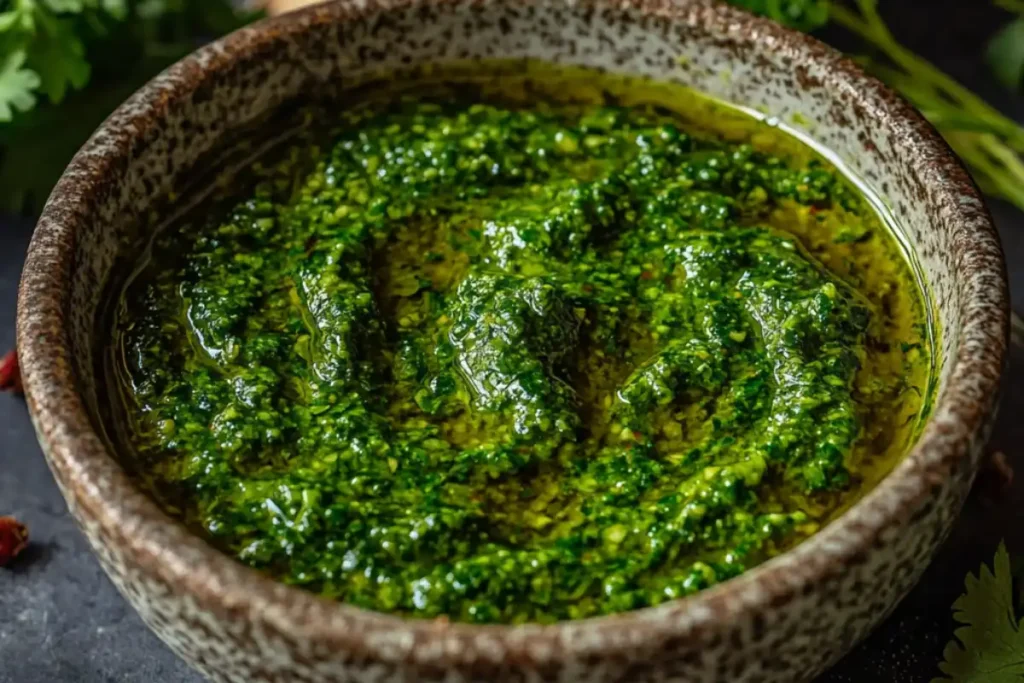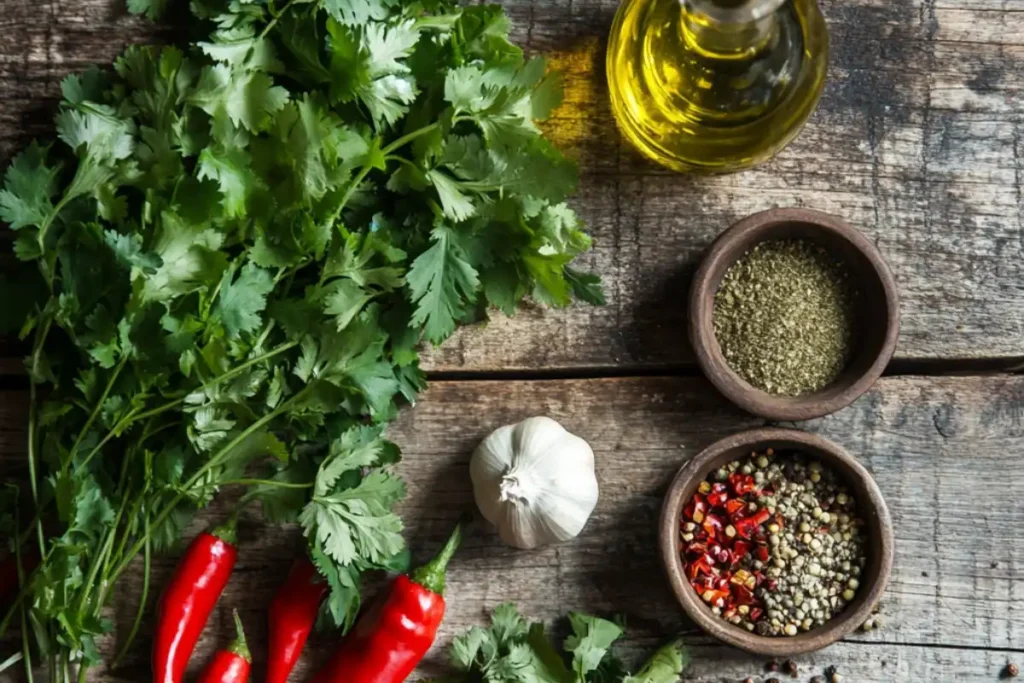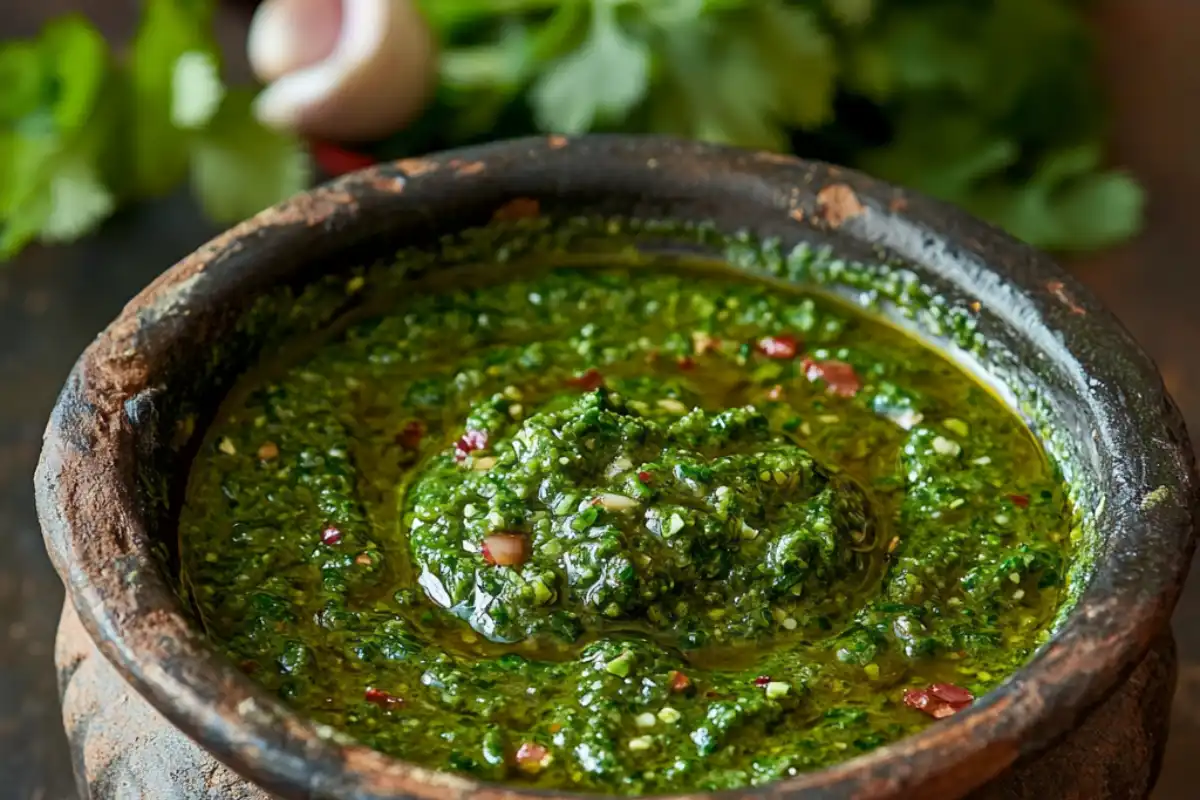Skhug (also known as zhug or shug) is a fiery, herbaceous sauce that originates from the Middle East, specifically Yemen. This zesty sauce has made its way across Middle Eastern kitchens, becoming a staple condiment in Israel, Palestine, and beyond. Skhug is known for its bold flavor, combining fresh herbs, chilies, garlic, and spices to create a sauce that’s as vibrant in color as it is in taste.
In this detailed guide, we’ll dive into everything you need to know about skhug, from its history and how to make it, to its popular uses and modern adaptations. Additionally, we’ll provide external and internal links to help you further explore the culinary world surrounding this exciting sauce.
1. What is Skhug?
Skhug, a traditional Middle Eastern hot sauce, features fresh cilantro, parsley, chilies, garlic, and olive oil as its primary ingredients. Its vibrant green or red color depends on the type of chilies used. The fresh herbs provide a bright, refreshing flavor, while the chilies bring the heat. This balance makes skhug incredibly versatile, serving as a condiment, dip, or marinade for various dishes.
There are three main varieties of skhug:
- Green Skhug: Made with green chilies and herbs, this is the most common version.
- Red Skhug: Made with red chilies, this version has a deeper flavor with slightly more heat.
- Brown Skhug: A less common variant made with dried chilies and spices, offering a smokier taste.

Many describe skhug as a Middle Eastern take on pesto or chimichurri, but with much more heat and a brighter herbal profile. Although traditionally a Yemeni condiment, Israeli cuisine has embraced skhug, making it a popular sauce for everything from falafel to shawarma.
Explore how other sauces can complement your meal with this Green Harissa Recipe.
2. The Origins and History of Skhug Sauce
Skhug originated in Yemen and was commonly made by the Jewish communities in the region. As Yemeni Jews migrated to Israel, they brought the recipe with them, where it quickly became a beloved part of Israeli cuisine. Today, skhug is as commonly found in Israel as ketchup is in the West, and it is frequently served alongside hummus, grilled meats, and pita bread.
This condiment’s rise to global fame is part of a larger trend in the culinary world, where chefs and home cooks alike are looking to the Middle East for bold, flavorful sauces and spreads. Skhug is now making its way into Western kitchens, often appearing in restaurants, home recipes, and grocery stores.
For a deeper dive into Yemeni flavors, consider pairing skhug with other Middle Eastern recipes like falafel, or use it as a condiment with Feta Cilantro Chicken Bowls, which also showcases cilantro as a key ingredient.
3. Key Ingredients in Skhug Sauce
Skhug’s flavor comes from a simple combination of fresh ingredients that are blended together to create a sauce that is both spicy and refreshing. Here’s what you’ll need to make a basic skhug:
- Fresh Cilantro: The dominant herb in skhug, cilantro provides a fresh, citrusy flavor that balances the heat of the chilies.
- Fresh Parsley: Parsley adds an extra layer of herbaceousness and freshness to the sauce.
- Green or Red Chilies: The type of chili used will determine the color and heat level of the sauce. Green chilies make green skhug, while red chilies make red skhug.
- Garlic: Adds a pungent, aromatic flavor that enhances the overall taste of the sauce.
- Olive Oil: The olive oil helps to blend the ingredients and adds a rich, smooth texture.If you’re interested in learning more about the different ways to use olive oil in your cooking, check out this guide to using olive oil in cooking.
- Spices: Ground cumin, coriander, and cardamom are commonly added to give the sauce warmth and depth.To explore more about these and other common spices in Middle Eastern cuisine, check out this guide to Middle Eastern spices.

These ingredients are blended together to create a sauce with a smooth but slightly chunky texture. The freshness of the herbs combined with the heat from the chilies makes skhug an incredibly versatile condiment.
Looking for a similar fresh and spicy recipe? Check out this guide on How to Use Green Harissa for another take on a fresh herb-based sauce.
4. How to Make Skhug Sauce: A Step-by-Step Recipe
Making skhug at home is simple and rewarding. Here’s a step-by-step recipe to help you create this bold sauce in your kitchen.
Ingredients:
- 1 large bunch of cilantro (stems and leaves)
- 1/2 cup of fresh parsley (leaves only)
- 4-6 green or red chilies (adjust to your heat preference)
- 4 cloves of garlic
- 1 teaspoon ground cumin
- 1 teaspoon ground coriander
- 1/2 teaspoon ground cardamom (optional)
- 1/2 cup extra virgin olive oil
- Juice of 1 lemon
- Salt to taste
Instructions:
- Prepare the Herbs: Wash the cilantro and parsley thoroughly. Remove the thicker stems from the parsley.
- Blend the Ingredients: In a food processor, combine the cilantro, parsley, chilies, garlic, and spices. Pulse until finely chopped but still slightly coarse in texture.
- Add the Olive Oil: While the food processor is running, slowly drizzle in the olive oil until the sauce is well blended but not overly smooth. The texture should remain slightly chunky.
- Season and Serve: Add lemon juice and salt to taste. Blend again briefly, then transfer to a jar or bowl.
Your homemade skhug will keep in the refrigerator for up to a week in an airtight container. Skhug can also be frozen in small batches for later use, allowing you to always have this flavorful sauce on hand.
5. Popular Uses for Skhug Sauce
The versatility of skhug is one of the reasons why it has become so popular beyond the Middle East. It can be used in a variety of ways to enhance dishes with its bold, spicy flavor. Here are some of the most common uses:
- As a Condiment for Grilled Meats: Skhug is often served with grilled chicken, lamb, or beef. Its fresh heat pairs perfectly with the smokiness of grilled meats.
- Spread on Sandwiches and Wraps: Use skhug as a spread for sandwiches or wraps, especially those with falafel, shawarma, or grilled vegetables.
- Drizzled on Vegetables: Whether you’re roasting or grilling vegetables, skhug can add a kick of flavor. Try drizzling it over roasted carrots, eggplant, or zucchini.
- Mixed into Hummus or Yogurt: Stirring skhug into hummus or yogurt creates a new dip with an added layer of flavor.
- Tossed with Pasta: For a quick and flavorful pasta dish, toss freshly cooked pasta with skhug and a bit of additional olive oil.

For more ideas on using skhug in your meals, consider trying it as a topping for Street Corn Pasta Salad, which balances creamy and spicy flavors perfectly.
6. Skhug Sauce vs. Other Spicy Sauces
While skhug is a unique condiment, it’s often compared to other popular sauces from the Middle East and beyond. Here’s how it stacks up against some well-known spicy sauces:
Skhug vs. Harissa
- Harissa is a North African chili paste made from dried chilies, garlic, and spices like cumin and coriander. It’s generally smokier and less fresh-tasting than skhug, which uses fresh herbs and chilies.If you’re curious about harissa’s specific ingredients, you can learn more in this guide on what harissa is made of.
vs. Salsa Verde
- Salsa Verde (typically Mexican) is also a fresh green sauce, but it uses tomatillos and a mix of chilies. Skhug, on the other hand, is all about the herbs, making it more aromatic and herb-forward.
vs. Chimichurri
- Chimichurri, from Argentina, is a fresh herb sauce similar to skhug but with a focus on parsley and vinegar. While chimichurri is tangy and mild, skhug is spicy and intense.
7. Skhug Sauce in Modern Cuisine
Skhug is no longer limited to Middle Eastern dishes. Its bold, fresh flavor has made it a popular ingredient in modern fusion cuisine. Here are a few ways skhug is being used in contemporary dishes:
- On Pizza: Drizzle skhug over pizza before serving for an added kick. It works especially well on pizzas with roasted vegetables or grilled meats.
- In Grain Bowls: Skhug adds a punch of flavor to grain bowls made with quinoa, farro, or brown rice. Drizzle it over grains with roasted vegetables and a protein for a complete meal.
- With Eggs: Skhug pairs surprisingly well with egg dishes. Drizzle it over scrambled eggs or shakshuka for a spicy start to your day.
To see how versatile skhug can be in modern cuisine, try using it as a spicy topping for grilled shrimp or as a drizzle over Sourdough Banana Muffins, for a bold flavor contrast in savory dishes.
FAQs about Skhug Sauce
1. What is Skhug made of?
- Fresh cilantro, parsley, chilies, garlic, olive oil, and spices like cumin and coriander combine to create skhug. The type of chili used determines whether the skhug is red or green.
2. How spicy is Skhug?
- Skhug can be quite spicy, depending on the number and type of chilies used. You can adjust the heat level to suit your taste by using fewer chilies or removing the seeds.
3. What is the difference between green and red Skhug?
- The primary difference is the type of chilies used. Green skhug is made with green chilies, while red skhug uses red chilies. Red skhug often has a smokier, slightly more intense heat than green skhug.
4. How long does Skhug last in the refrigerator?
- Skhug can last up to a week in the fridge when stored in an airtight container. You can also freeze it in small portions to extend its shelf life.
5. Can I make Skhug less spicy?
- Yes! To reduce the heat, you can remove the seeds from the chilies or use milder varieties of chilies. Adding more herbs, like cilantro or parsley, can also help mellow out the spice.
8. Conclusion
Skhug is more than just a spicy condiment; it’s a versatile, flavorful sauce that brings heat and brightness to any dish it touches. Whether you’re spreading it on a sandwich, drizzling it over vegetables, or using it as a marinade, skhug adds a depth of flavor that enhances everything from traditional Middle Eastern dishes to modern fusion cuisine.
With its simple ingredients and easy preparation, skhug is a must-try for anyone who loves bold, vibrant flavors. As it continues to gain popularity across the globe, skhug is cementing its place in kitchens everywhere.
For more spicy condiment inspiration, explore our recipe for Green Harissa Substitutes and discover new ways to spice up your meals.

